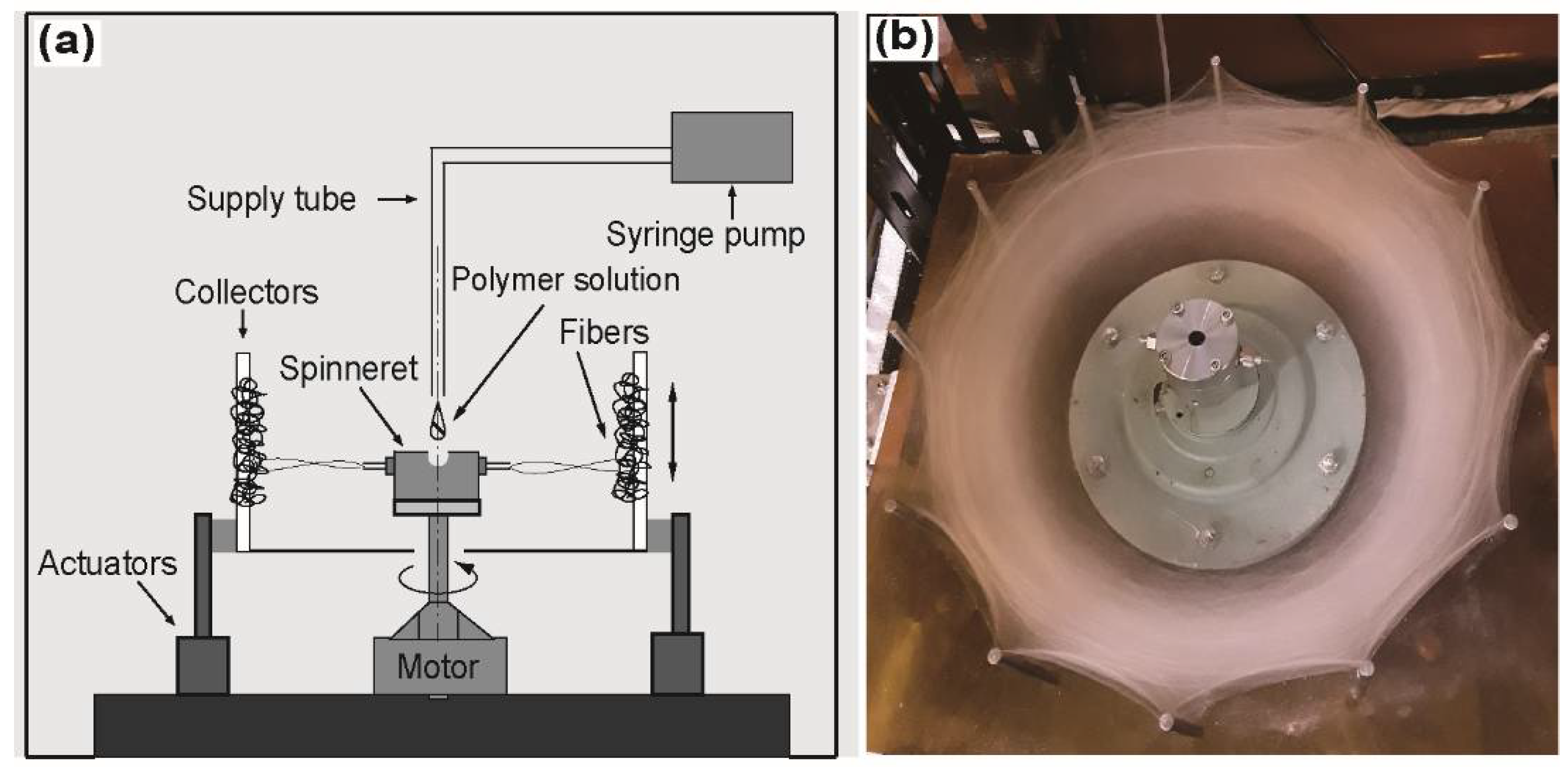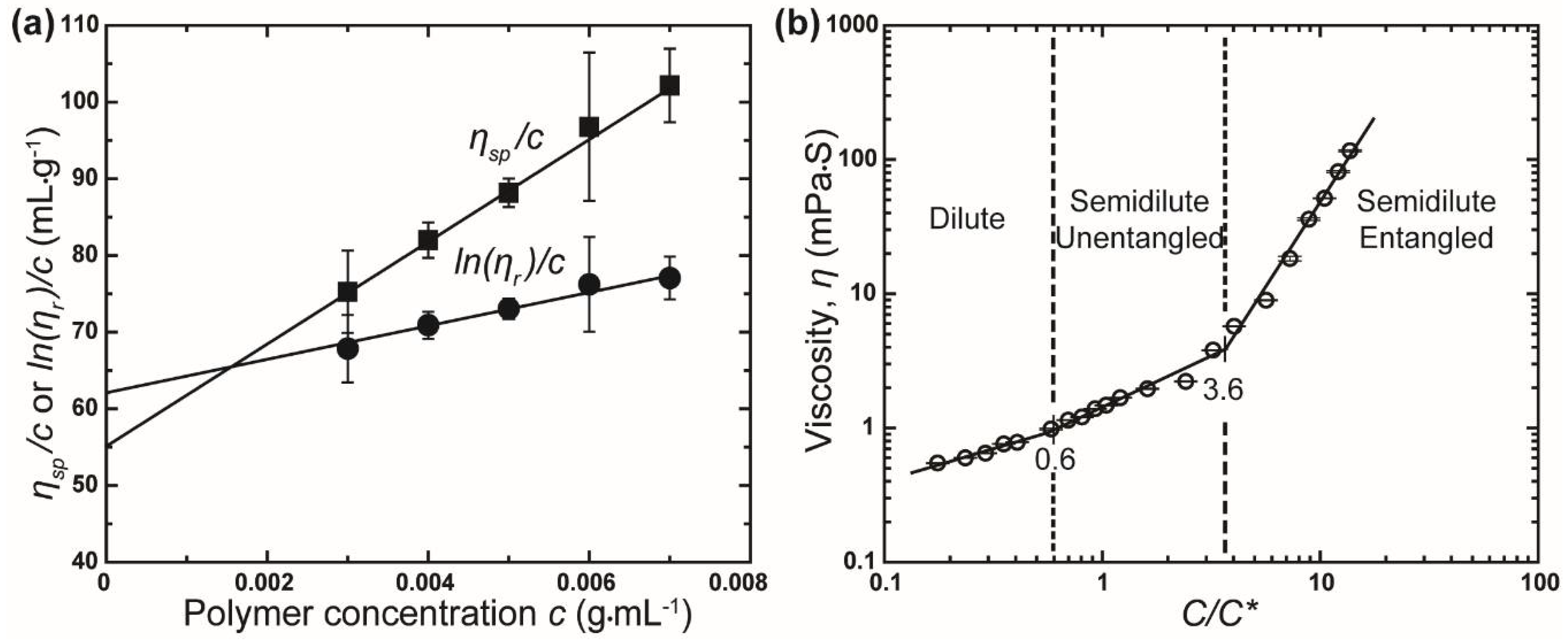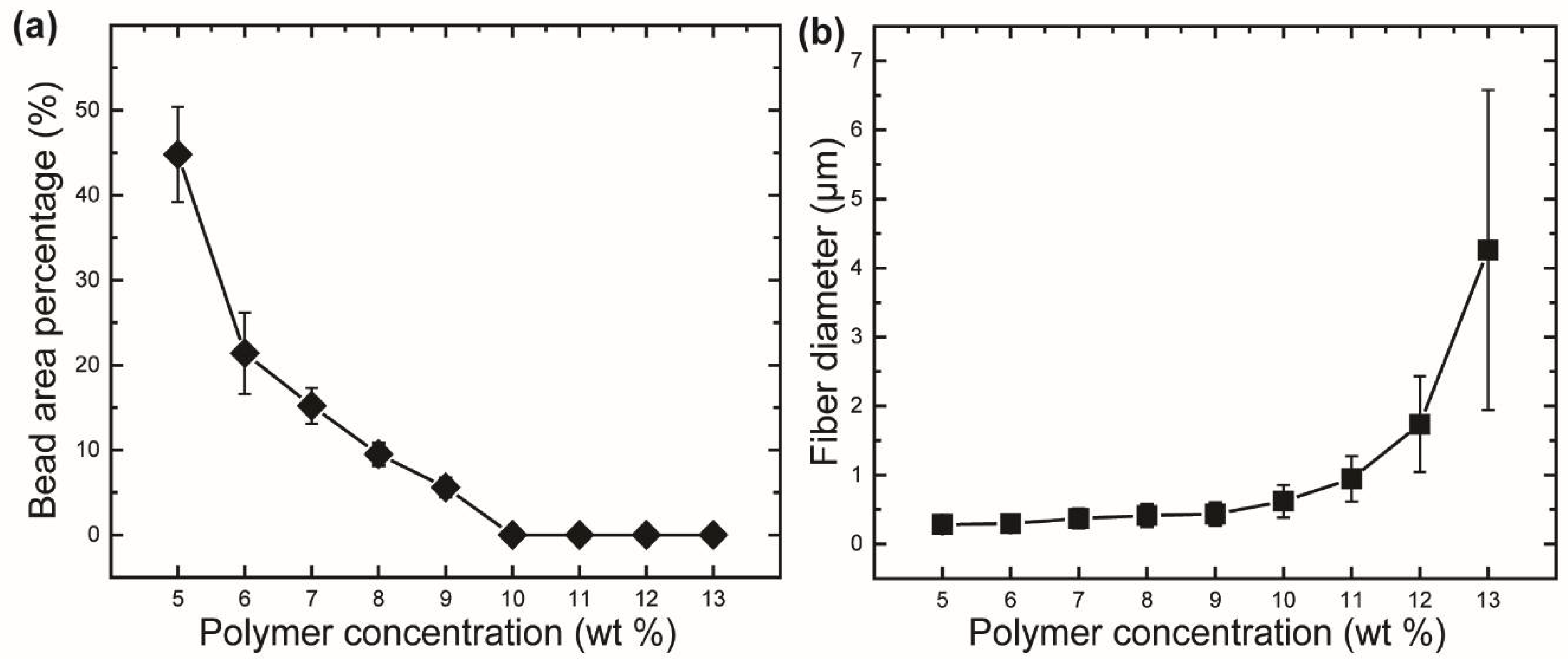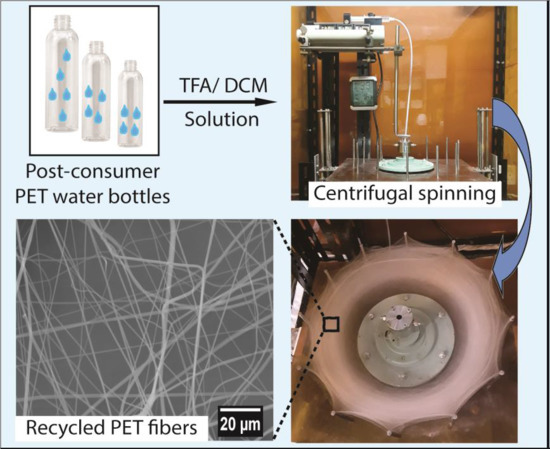Centrifugally Spun Recycled PET: Processing and Characterization
Abstract
:1. Introduction
2. Materials and Methods
2.1. Materials
2.2. Solution Preparation and Centrifugal Spinning Process
2.3. Characterization
3. Results and Discussion
3.1. Solution Intrinsic Viscosity
3.2. Effect of Experimental Parameters on Morphology and Diameter of Fibers
3.3. Mechanical Properties
3.4. Thermal Properties
4. Conclusions
Supplementary Materials
Author Contributions
Funding
Acknowledgments
Conflicts of Interest
References
- Fischer, E.W.; Fakirov, S. Structure and properties of polyethyleneterephthalate crystallized by annealing in the highly oriented state. J. Mater. Sci. 1976, 11, 1041–1065. [Google Scholar] [CrossRef]
- Kunugi, T.; Suzuki, A.; Hashimoto, M. Mechanical properties and superstructure of high-modulus and high-strength PET fiber prepared by zone annealing. J. Appl. Polym. Sci. 1981, 26, 1951–1960. [Google Scholar] [CrossRef]
- Yoshida, S.; Hiraga, K.; Takehana, T.; Taniguchi, I.; Yamaji, H.; Maeda, Y.; Toyohara, K.; Miyamoto, K.; Kimura, Y.; Oda, K. A bacterium that degrades and assimilates poly(ethylene terephthalate). Science 2016, 351, 1196–1199. [Google Scholar] [CrossRef] [PubMed]
- Welle, F. Twenty years of PET bottle to bottle recycling—An overview. Resour. Conserv. Recycl. 2011, 55, 865–875. [Google Scholar] [CrossRef]
- Frigione, M. Recycling of PET bottles as fine aggregate in concrete. Waste Manag. 2010, 30, 1101–1106. [Google Scholar] [CrossRef] [PubMed]
- The Council for PET Bottle Recycling. Available online: http://www.petbottle-rec.gr.jp/english/ (accesed on 30 March 2018).
- Strain, I.N.; Wu, Q.; Pourrahimi, A.M.; Hedenqvist, M.S.; Olsson, R.T.; Andersson, R.L. Electrospinning of recycled PET to generate tough mesomorphic fibre membranes for smoke filtration. J. Mater. Chem. A 2015, 3, 1632–1640. [Google Scholar] [CrossRef] [Green Version]
- Zander, N.E.; Gillan, M.; Sweetser, D. Recycled PET nanofibers for water filtration applications. Materials 2016, 9, 247. [Google Scholar] [CrossRef] [PubMed]
- Jung, J.W.; Lee, C.L.; Yu, S.; Kim, I.D. Electrospun nanofibers as a platform for advanced secondary batteries: A comprehensive review. J. Mater. Chem. A 2016, 4, 703–750. [Google Scholar] [CrossRef]
- Senthamizhan, A.; Celebioglu, A.; Uyar, T. Flexible and highly stable electrospun nanofibrous membrane incorporating gold nanoclusters as an efficient probe for visual colorimetric detection of Hg(II). J. Mater. Chem. A 2014, 2, 12717–12723. [Google Scholar] [CrossRef]
- Santoro, M.; Shah, S.R.; Walker, J.L.; Mikos, A.G. Poly(lactic acid) nanofibrous scaffolds for tissue engineering. Adv. Drug Deliv. Rev. 2016, 107, 206–212. [Google Scholar] [CrossRef] [PubMed] [Green Version]
- Hu, X.; Liu, S.; Zhou, G.; Huang, Y.; Xie, Z.; Jing, X. Electrospinning of polymeric nanofibers for drug delivery applications. J. Control. Release 2014, 185, 12–21. [Google Scholar] [CrossRef] [PubMed]
- Zuo, F.; Zhang, S.; Liu, H.; Fong, H.; Yin, X.; Yu, J.; Ding, B. Free-Standing Polyurethane Nanofiber/Nets Air Filters for Effective PM Capture. Small 2017, 13. [Google Scholar] [CrossRef] [PubMed]
- Stojanovska, E.; Canbay, E.; Pampal, E.S.; Calisir, M.D.; Agma, O.; Polat, Y.; Simsek, R.; Gundogdu, N.A.S.; Akgul, Y.; Kilic, A. Review on non-electro nanofibre spinning techniques. RSC Adv. 2016, 6, 83783–83801. [Google Scholar] [CrossRef]
- Luo, C.J.; Stoyanov, S.D.; Stride, E.; Pelan, E.; Edirisinghe, M. Electrospinning versus fibre production methods: From specifics to technological convergence. Chem. Soc. Rev. 2012, 41, 4708–4735. [Google Scholar] [CrossRef] [PubMed]
- Badrossamay, M.R.; McIlwee, H.A.; Goss, J.A.; Parker, K.K. Nanofiber assembly by rotary jet-spinning. Nano Lett. 2010, 10, 2257–2261. [Google Scholar] [CrossRef] [PubMed]
- Sarkar, K.; Gomez, C.; Zambrano, S.; Ramirez, M.; De Hoyos, E.; Vasquez, H.; Lozano, K. Electrospinning to ForcespinningTM. Mater. Today 2010, 13, 12–14. [Google Scholar] [CrossRef]
- Loordhuswamy, A.M.; Krishnaswamy, V.R.; Korrapati, P.S.; Thinakaran, S.; Rengaswami, G.D.V. Fabrication of highly aligned fibrous scaffolds for tissue regeneration by centrifugal spinning technology. Mater. Sci. Eng. C 2014, 42, 799–807. [Google Scholar] [CrossRef] [PubMed]
- Yanilmaz, M.; Lu, Y.; Li, Y.; Zhang, X. SiO2/polyacrylonitrile membranes via centrifugal spinning as a separator for Li-ion batteries. J. Power Sources 2015, 273, 1114–1119. [Google Scholar] [CrossRef]
- Doan, H.N.; Tsuchida, H.; Iwata, T.; Kinashi, K.; Sakai, W.; Tsutsumi, N.; Huynh, D.P. Fabrication and photochromic properties of Forcespinning® fibers based on spiropyran-doped poly(methyl methacrylate). RSC Adv. 2017, 7, 33061–33067. [Google Scholar] [CrossRef]
- Buzgo, M.; Rampichova, M.; Vocetkova, K.; Sovkova, V.; Lukasova, V.; Doupnik, M.; Miclova, A.; Rustichelli, F.; Amler, E. Emulsion centrifugal spinning for production of 3D drug releasing nanofibres with core/shell structure. RSC Adv. 2017, 7, 1215–1228. [Google Scholar] [CrossRef] [Green Version]
- Zander, N.E.; Gillan, M.; Sweetser, D. Composite fibers from recycled plastics using melt centrifugal spinning. Materials 2017, 10, 1044. [Google Scholar] [CrossRef]
- Lu, Y.; Li, Y.; Zhang, S.; Xu, G.; Fu, K.; Lee, H.; Zhang, X. Parameter study and characterization for polyacrylonitrile nanofibers fabricated via centrifugal spinning process. Eur. Polym. J. 2013, 49, 3834–3845. [Google Scholar] [CrossRef]
- Ren, L.; Pandit, V.; Elkin, J.; Denman, T.; Cooper, J.A.; Kotha, S.P. Large-scale and highly efficient synthesis of micro- and nano-fibers with controlled fiber morphology by centrifugal jet spinning for tissue regeneration. Nanoscale 2013, 5, 2337. [Google Scholar] [CrossRef] [PubMed]
- Gupta, P.; Elkins, C.; Long, T.E.; Wilkes, G.L. Electrospinning of linear homopolymers of poly(methyl methacrylate): Exploring relationships between fiber formation, viscosity, molecular weight and concentration in a good solvent. Polymer 2005, 46, 4799–4810. [Google Scholar] [CrossRef]
- Huggins, M.L. The viscosity of dilute solutions of long-chain molecules. IV. Dependence on concentration. J. Am. Chem. Soc. 1942, 64, 2716–2718. [Google Scholar] [CrossRef]
- Kraemer, E.O. Molecular weights of celluloses and cellulose derivates. Ind. Eng. Chem. 1938, 30, 1200–1203. [Google Scholar] [CrossRef]
- Golecki, H.M.; Yuan, H.Y.; Glavin, C.; Potter, B.; Badrossamay, M.R.; Goss, J.A.; Phillips, M.D.; Parker, K.K. Effect of solvent evaporation on fiber morphology in rotary jet spinning. Langmuir 2014, 30, 13369–13374. [Google Scholar] [CrossRef] [PubMed]
- Mellado, P.; McIlwee, H.A.; Badrossamay, M.R.; Goss, J.A.; Mahadevan, L.; Kit Parker, K. A simple model for nanofiber formation by rotary jet-spinning. Appl. Phys. Lett. 2011, 99, 203107. [Google Scholar] [CrossRef] [Green Version]
- McEachin, Z.; Lozano, K. Production and characterization of polycaprolactone nanofibers via forcespinning™ technology. J. Appl. Polym. Sci. 2012, 126, 473–479. [Google Scholar] [CrossRef]
- Padron, S.; Fuentes, A.; Caruntu, D.; Lozano, K. Experimental study of nanofiber production through forcespinning. J. Appl. Phys. 2013, 113, 024318. [Google Scholar] [CrossRef]
- Hammami, M.A.; Krifa, M.; Harzallah, O. Centrifugal force spinning of PA6 nanofibers–processability and morphology of solution-spun fibers. J. Text. Inst. 2014, 105, 637–647. [Google Scholar] [CrossRef]
- Vazquez, B.; Vasquez, H.; Lozano, K. Preparation and characterization of polyvinylidene fluoride nanofibrous membranes by forcespinning™. Polym. Eng. Sci. 2012, 52, 2260–2265. [Google Scholar] [CrossRef]
- Wang, C.; Lee, M.F.; Wu, Y.J. Solution-electrospun poly(ethylene terephthalate) fibers: Processing and characterization. Macromolecules 2012, 45, 7939–7947. [Google Scholar] [CrossRef]











| rPET Concentration (wt %) | Mechanical Properties | ||
|---|---|---|---|
| Tensile Strength (MPa) | Modulus (MPa) | Strain at Break (%) | |
| 7 | 3.5 ± 0.7 | 21.6 ± 4.4 | 100 ± 20 |
| 10 | 4.3 ± 0.2 | 34.4 ± 7.1 | 167 ± 32 |
| 13 | 9.2 ± 1.4 | 192 ± 56.1 | 237 ± 74 |
| Rotational Speed (rpm) | Mechanical Properties | ||
|---|---|---|---|
| Tensile Strength (MPa) | Modulus (MPa) | Strain at Break (%) | |
| 15,000 | 4.3 ± 0.2 | 34.4 ± 7.1 | 167 ± 32 |
| 12,000 | 3.5 ± 0.5 | 18.2 ± 4.7 | 216 ± 26 |
| 9000 | 1.1 ± 0.1 | 12.2 ± 5.1 | 96 ± 20 |
| 6000 | 0.5 ± 0.1 | 4.3 ± 3.2 | 92 ± 14 |
| Inner Diameter of Needles (μm) | Mechanical Properties | ||
|---|---|---|---|
| Tensile Strength (MPa) | Modulus (MPa) | Strain at Break (%) | |
| 160 | 4.3 ± 0.2 | 34.4 ± 7.1 | 167 ± 32 |
| 260 | 4.5 ± 0.4 | 32.1 ± 5.1 | 162 ± 13 |
| 340 | 7.8 ± 1.9 | 54.3 ± 15.0 | 205 ± 28 |
| Inner Diameter of Needles (μm) | Thermal Properties | |
|---|---|---|
| Tg (°C) | (%) | |
| 160 | 73.3 ± 1.0 | 15.1 ± 0.1 |
| 260 | 77.2 ± 0.7 | 13.1 ± 0.6 |
| 340 | 78.1 ± 0.5 | 11.6 ± 1.3 |
© 2018 by the authors. Licensee MDPI, Basel, Switzerland. This article is an open access article distributed under the terms and conditions of the Creative Commons Attribution (CC BY) license (http://creativecommons.org/licenses/by/4.0/).
Share and Cite
Vo, P.P.; Doan, H.N.; Kinashi, K.; Sakai, W.; Tsutsumi, N.; Huynh, D.P. Centrifugally Spun Recycled PET: Processing and Characterization. Polymers 2018, 10, 680. https://doi.org/10.3390/polym10060680
Vo PP, Doan HN, Kinashi K, Sakai W, Tsutsumi N, Huynh DP. Centrifugally Spun Recycled PET: Processing and Characterization. Polymers. 2018; 10(6):680. https://doi.org/10.3390/polym10060680
Chicago/Turabian StyleVo, Phu Phong, Hoan Ngoc Doan, Kenji Kinashi, Wataru Sakai, Naoto Tsutsumi, and Dai Phu Huynh. 2018. "Centrifugally Spun Recycled PET: Processing and Characterization" Polymers 10, no. 6: 680. https://doi.org/10.3390/polym10060680






